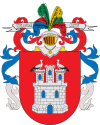Irun, Spain
| Irun | ||
|---|---|---|
| Municipality | ||

Irun City Hall
|
||
|
||
| Motto: Vigilantiae Custos | ||
| Location of Irun within the Basque Autonomous Community | ||
| Coordinates: 43°20′16.13″N 1°47′19.72″W / 43.3378139°N 1.7888111°WCoordinates: 43°20′16.13″N 1°47′19.72″W / 43.3378139°N 1.7888111°W | ||
| Country | Spain | |
| Autonomous community | Basque Country | |
| Province | Gipuzkoa | |
| Comarca | Bidasoaldea | |
| Founded | 28 February 1776 | |
| Government | ||
| • Mayor | José Antonio Santano Clavero (2007) (PSE-EE) | |
| Area | ||
| • Total | 42.40 km2 (16.37 sq mi) | |
| Elevation | 20 m (70 ft) | |
| Highest elevation | 825 m (2,707 ft) | |
| Lowest elevation | 5 m (16 ft) | |
| Population (2016) | ||
| • Total | 61,608 | |
| • Density | 1,500/km2 (3,800/sq mi) | |
| Demonym(s) | irundar, irunés/irunesa | |
| Time zone | CET (UTC+1) | |
| • Summer (DST) | CEST (UTC+2) | |
| Postal code | 20300-20305 | |
| Website | Official website | |
Irun (Spanish: Irún, Basque: Irun) is a town of the Bidasoaldea region in the province of Gipuzkoa in the Basque Autonomous Community, Spain. It lies on the foundations of the ancient Oiasso, cited as a Roman-Vasconic town during the period.
One of the biggest towns in Gipuzkoa, its border town situation (it is located on the border between Spain and France, across the Bidasoa river from Hendaye), has made Irun into a commercial and logistic centre, with important railway infrastructure, where the SNCF 1,435 mm (4 ft 8 1⁄2 in) standard gauge rails meet the 1,668 mm (5 ft 5 21⁄32 in) broad gauge Renfe ones. Currently Irun features a fair ground provided with modern exhibition and telecommunication facilities just at some 100 metres away from the actual borderline at the Santiago Bridge (river Bidasoa).
Irun is part of the conurbation of Txingudi bay with Hondarribia and Hendaye, the town being also involved in the Eurocité Basque Bayonne-San Sebastián ().
...
Wikipedia


